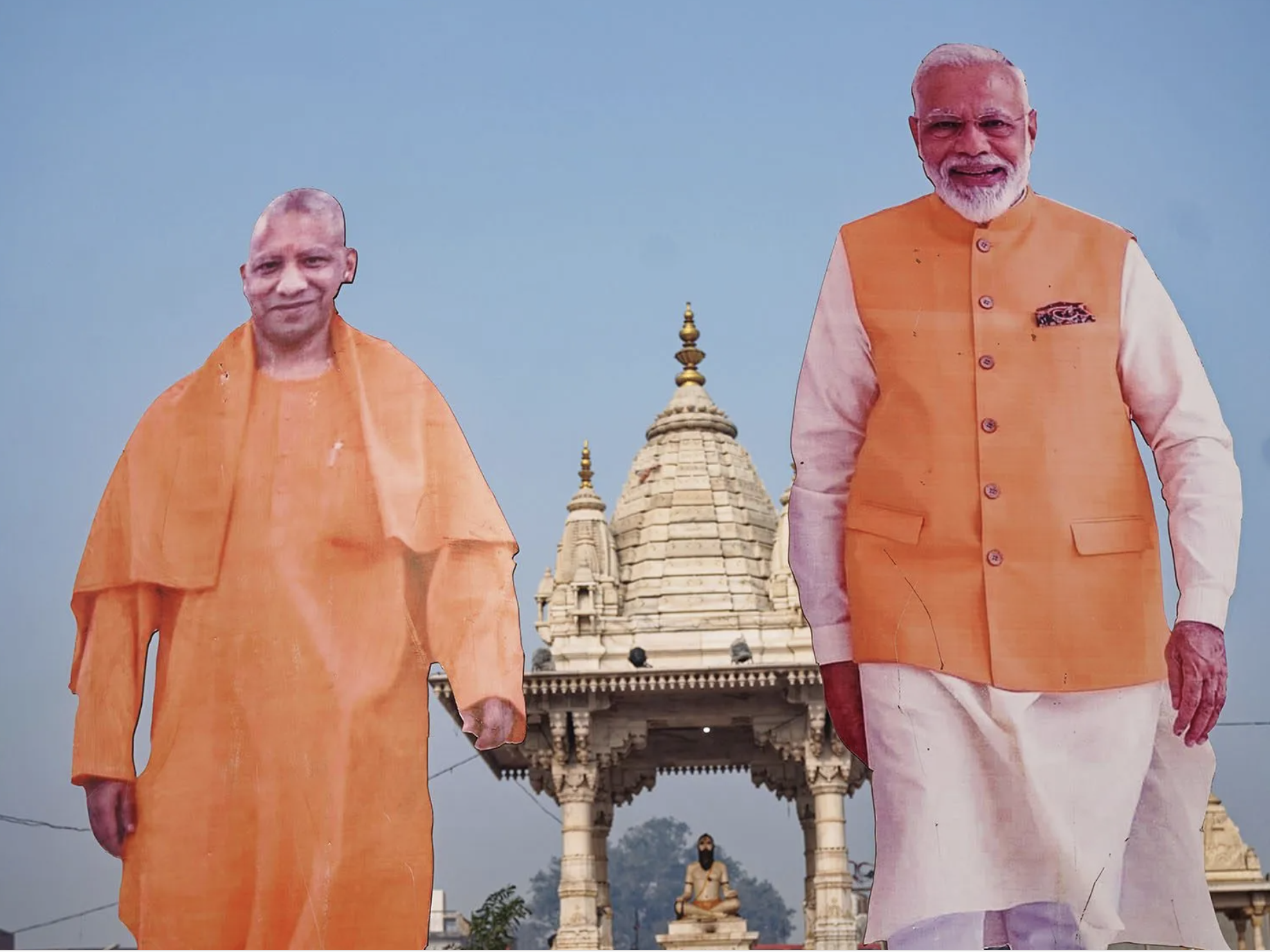To some, Modi’s new temple embodies the revival of a Hindu golden age. To others, it symbolizes the waning of a pluralist nation.

AYODHYA, India—At the end of January, devotees from far and wide congregated in this northern Indian city before a new temple to pay tribute to Ram, the warrior-deity hero of the ancient Sanskrit epic the Ramayana. The gleaming temple built in Ram’s honor—the Ram Mandir—had been inaugurated less than a week before, but the carpet leading to gender-segregated metal detectors already looked threadbare.
Indian Prime Minister Narendra Modi presided over the site’s consecration on Jan. 22. The day after, half a million worshippers flooded Ayodhya. They discarded their shoes behind a metal barricade. Men in knit neon-orange caps lunged up the polished sandstone, pausing to touch each step. The temple’s pillars were wrapped in lilies, roses, carnations, and a blue floral peacock with a cascading tail. The milky white sanctum glimmered like a mirage.
“Jai Shri Ram!” chanters bellowed. (“Victory to Lord Ram!”) Inside the temple, devotees locked eyes with the black-stone Ram Lalla, the site’s main idol, for a few seconds before being ushered along by uniformed guards.

Scenes from the Ramayana, including a portrait of Sita, Ram, and Ram’s brother Lakshmana, adorn a new bus stop
Scenes from the Ramayana, including a portrait of Sita, Ram, and Ram’s brother Lakshmana, adorn a new bus stop in Ayodhya on Jan. 29.

Giant cut-outs of Chief Minister of Uttar Pradesh Yogi Aditanath and Prime Minister Narendra Modi
Giant cutouts of Uttar Pradesh Chief Minister Yogi Adityanath and Prime Minister Narendra Modi soar over a statue of 16th-century sage Tulsidas in Tulsi Udyan, a park in Ayodhya, on Jan. 30.
To many Indians, Ram Mandir’s opening embodies the revival of a Hindu golden age, a time predating Mughal invasions and Britain’s colonial chokehold. At a ceremony to lay the temple’s foundation stone in 2020, Modi said, “Ram Temple will be a modern signifier of our ancient culture; it will be an example of our patriotic fervor; it will be a symbol of the strength of will of our citizens.” The trust set up that year to manage the temple’s construction released a 3D animation on YouTube detailing each stage of the process. One commenter declared the temple a “soul-fulfilling achievement of lost glory.”
To others, Ram Mandir symbolizes the waning of a pluralist India that offered safe harbor to religious minorities for centuries. Modi and his Bharatiya Janata Party (BJP) have consolidated their base by politicizing Hindu religious and cultural identity. India’s main opposition, the secular Indian National Congress party, declined to attend the star-studded temple opening. Prakash Ambedkar, a former member of parliament and founder of the anti-caste Vanchit Bahujan Aghadi party, tweeted that the BJP was “trying to appropriate God.”
Now in Ayodhya, weeks after the temple’s consecration, illustrated posters of Ram—sky-blue skin, traditional bow in hand—still plaster the streets. He is joined by larger-than-life cutouts of Yogi Adityanath (the BJP chief minister of the state of Uttar Pradesh, where Ayodhya is located) and an orange-clad Modi. They tower over a statue of Tulsidas, a 17th-century sage who popularized the Ramayana by translating it into the regional dialect.
As India looks ahead to general elections this spring, the shrewdly timed inauguration of Ram Mandir—which is still under construction—has fulfilled one of the BJP’s most ardent campaign promises.

Temples line the Ayodhya waterfront, cranes in the distance. Much of the city is still under reconstruction, converted into a so-called “Hindu vatican” on Jan. 29.
Temples line the Ayodhya waterfront, with cranes visible in the distance, on Jan. 29. Much of the city is still under reconstruction, converted into a so-called “Hindu Vatican.”
Ram Mandir’s hallowed grounds were once home to a 16th-century mosque, the Babri Masjid. Built under the first Mughal emperor, Babur, in 1528-29, the mosque emerged as a flash point for Hindu-Muslim tensions in the mid-1850s, when Hindu groups alleged it lay on top of the location believed to be the birthplace of Ram.
In 1856, Britain’s East India Company annexed the region home to Ayodhya. The British built a wall to separate Hindu and Muslim worship. The next year, in a rebellion known as the Sepoy Mutiny, Hindu and Muslim soldiers rallied against a common British target—temporarily allaying tensions surrounding the Babri Masjid. “Hindu-Muslim unity during the rebellion showed the British that they [could not] rule without playing one against another,” journalist Valay Singh told Foreign Policy. Singh is the author of the book Ayodhya: City of Faith, City of Discord.
From then on, divide and conquer was the colonial modus operandi. By 1885, the Ayodhya site dispute became the subject of litigation. A petition to build a Hindu temple on the site was dismissed in court. Further communal riots followed in the 1930s. Then, just two years into India’s independence in 1949, a Hindu ascetic broke into the Babri Masjid, where he planted an idol of Ram. Onlookers heralded it a divine apparition. Authorities officially declared the site disputed and locked the mosque.
A right-wing Hindu nationalist organization launched the movement to build a temple at the Babri Masjid site in 1984. Its slogan—Mandir wahi banayenge, or “we will build a temple right there”—was embraced as a rallying cry by the BJP. In 1992, Ram Temple activists famously charged the mosque and hacked it down with axes and hammers; worshippers filed past cleared rubble to offer prayers to Ram.
By Ariel Sophia Bardi, a freelance writer and photographer based in Rome.
Excerpts: Foreign policy




COMMENTS